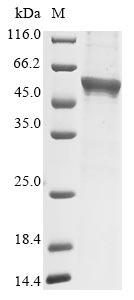The expression region of this recombinant Mouse Pla2g7 covers amino acids 22-440. The calculated molecular weight for this Pla2g7 protein is 50.7 kDa. This protein is generated in a baculovirus-based system. The Pla2g7 gene fragment has been modified by fusing the N-terminal 10xHis tag and C-terminal Myc tag, providing convenience in detecting and purifying the recombinant Pla2g7 protein during the following stages.
The mouse platelet-activating factor acetylhydrolase (Pla2g7) is an enzyme involved in the metabolism of platelet-activating factor (PAF, a potent pro-inflammatory mediator implicated in various physiological processes, including inflammation, immune response, and cardiovascular function. By hydrolyzing PAF, Pla2g7 counteracts its pro-inflammatory effects. This activity contributes to the resolution of inflammation and the prevention of excessive immune responses. Pla2g7 is associated with cardiovascular health. Elevated levels of Pla2g7 have been linked to atherosclerosis and cardiovascular diseases. It serves as a potential biomarker for assessing cardiovascular risk. Pla2g7 is associated with lipoproteins, particularly high-density lipoprotein (HDL). It participates in the hydrolysis of oxidized phospholipids in lipoproteins, influencing their function and metabolism. Understanding the role of mouse platelet-activating factor acetylhydrolase is important for unraveling the complexities of inflammatory processes and lipid metabolism, particularly in the context of cardiovascular health.




